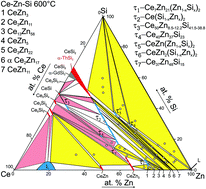The system Ce–Zn–Si for <33.3 at.% Ce: phase relations, crystal structures and physical properties†
Abstract
Phase equilibria of the system Ce–Zn–Si have been determined for the isothermal section at 600 °C for <33.3 at.% Ce by XRPD and EPMA. This partial section is characterized by the formation of five ternary compounds with homogeneity regions at constant Ce-content and partial substitution of Zn/Si: τ1-Ce7Zn21(Zn1−xSix)2 (unique type; 0.45 ≤ x ≤ 0.99), τ2-Ce(Si1−xZnx)2 (AlB2-type; 0.36 ≤ x ≤ 0.73), τ5-CeZn(Zn1−xSix)2 (CeNiSi2-type; 0.68 ≤ x ≤ 0.76), τ6-CeZn2(Si1−xZnx)2 (ThCr2Si2-type; 0.25 ≤ x ≤ 0.30) and τ7-Ce37Zn48Si15 (structure unknown). Whereas τ1, τ2 and τ5 are stable at 600 and 800 °C, the phases τ6, τ7 are unstable at 800 °C. Atom site distribution in the crystal structures of τ5, τ6 and {La,Ce}7Zn21(Zn1−xGex)2 have been elucidated from X-ray intensity refinements on single crystals. The small amounts of the stabilizing tetrel element in {La,Ce}7Zn21[Zn1−xSi(Ge)x]2 suggest a hypothetical binary phase “{La,Ce}7Zn23”. The stabilizing effect of Ge in Ce7Zn23−xGex has been elucidated from density functional theory (DFT) calculations discussing the electronic structure in terms of the density of states (DOS) and defining enthalpies of formation for Ce7Zn23−xGex (x = 0, 0.5, 2) as well as for several neighbouring binary Ce–Zn phases. A Schultz–Scheil diagram for the solidification behaviour in the (Zn,Si)-rich part of the diagram was constructed from DTA measurements in closed silica crucibles along with partial isothermal sections determined in the temperature range from 400 to 900 °C. The phases τ5 and τ6 both form in degenerate ternary peritectic reactions: L + CeSi2,β-Ce2Zn17 ⇔ τ5 at 865 ± 5 °C and L + τ5,CeZn11 ⇔ τ6 at 695 ± 5 °C, respectively. Magnetic susceptibility, specific heat and resistivity measurements of τ5-CeZn(Zn1−xSix)2 revealed Kondo lattice behavior with ferromagnetic ordering below TC = 4.4 K, whereas susceptibility and specific heat studies of τ6-CeZn2(Zn0.28Si0.72)2 revealed Curie–Weiss paramagnetic behaviour down to 3 K. The effective paramagnetic moments of Ce obtained from Curie–Weiss fits of τ5 (2.50μB) and τ6 (2.34μB) reveal a ground state close to trivalent Ce.


 Please wait while we load your content...
Please wait while we load your content...